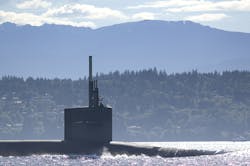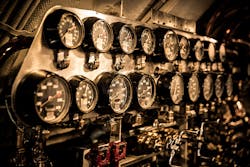A Submariner’s Perspective on Predictive Maintenance
“Dive! Dive!” Two simple words, punctuated with the familiar “ah-OOG-ah” alarm, signaled everyone throughout the ship that we were about to embark on another adventure under the sea. For many sailors, this quickly became routine. Nothing is routine, however, about submerging an 18,000-ton, 560-ft vessel carrying 165 people hundreds of feet beneath the surface of the ocean. One small defect or fault in any of dozens of systems or one valve out of position and our crew would find itself on a one-way trip to the bottom of the sea.
Despite all the complexities of multiple systems crammed into a tiny space, operating in harsh environments, the U.S. Navy has never had a death on board a U.S. submarine due to a radiation accident. How have they maintained such an amazing safety record?
The answer to this question begins with two submarine tragedies that occurred in the 1960s, which resulted in the Navy’s Submarine Safety (SUBSAFE) program that covers all systems exposed to sea pressure or that are critical to flooding recovery. SUBSAFE, along with the Navy’s Nuclear Power program, is based on a foundation of quality in design, material, fabrication, and testing. Remarkably, since the Navy’s nuclear submarine program began, only two subs have been lost at sea.
In the mid-1990s, I served as an officer onboard the Ohio-class nuclear submarine USS Nevada before starting my career in manufacturing. In recent years, preventing downtime has created abundant interest in using technology to make better maintenance decisions. At the heart of this technology are the fundamental principles of predictive maintenance (PdM): gathering data, analyzing it, predicting failures, and taking proactive measures to prevent downtime. These fundamental principles are unchanged from how we operated the Nevada 20 years ago. Let’s see what a nuclear submarine can teach us about avoiding costly downtime.
Navy submarines are always in a hostile environment. Not only do they face the potential threat of attack from another nation, but submarines are completely surrounded by saltwater, and storms at sea can be extremely hazardous — not to mention the explosive ordnance carried on board.
Aboard the USS Nevada, we used a variety of maintenance practices to ensure everything worked at peak performance, including weekly and monthly preventive maintenance (PM) inspections and check-off sheets for routine items like oil filter changes or motor-generator brush repair. The principle here was to do the maintenance at a specific interval, whether it needed to be done or not. When set up properly, this was an effective though conservative (and potentially wasteful) approach to doing maintenance.
However, just because the weekly or monthly PM was performed, there was no guarantee nothing would go wrong between cycles, resulting in a potentially catastropic system failure. Therefore, we added another feature into our daily operations — ongoing data collection and trend analysis. This is essentially how PdM works in industry today: continuously evaluating how your equipment is working so you know when and how to maintain it optimally.
The Nevada employed a team of 10 trained personnel who were responsible for operating the reactor plant, electrical, and propulsion systems 24/7 during time we were underway. This team worked in 6-hr shifts. When an issue or complex process arose, the team was there to address it, often with the help of another team of 10 people who were “off-duty”. This team would record the readings of all the hundreds of gauges, dials, and indicators throughout the engine room at least every hour or, in some cases, every 15 min. The watch team supervisors were expected to review these log readings every 3 hr, and the division officer (DO) and engineering officer (ENG) reviewed them daily. At first, this vast collection of numbers seemed overwhelming, but, with experience, the team gained a sense of what was normal and could quickly identify readings that signaled something amiss.One example of this is the bearing temperatures and oil flow bubblers of the main reduction gears. The reduction gears take the power generated by steam turbines turning at thousands of RPM and use it to drive the propulsion shaft at much slower speeds, which turns the screw and propels the submarine through the water. These gears are machined to extremely precise measurements and carry a lot of power. They are lubricated and cooled in a continuous flow of purified oil. If something were to happen to contaminate or stop the flow of oil, the gears could break or seize together, effectively shutting down the submarine’s propulsion system and rendering us dead in the water. There are dozens of bubbler sight glasses on the reduction gears that visually show both the flow and condition of the oil. These are recorded every hour, along with bearing temperatures to see that the reduction gears are being properly lubricated at all times. Using trend analysis to spot a problem in this system before it became downtime could determine whether we made it back home or not.
Writing down and reviewing all these numbers ensured that:
- The operator writing them down inspected the gauges every hour or 15 min. If the numbers were way outside of their expected position, they noticed something was wrong before a long period of time passed, enabling them to respond quickly.
- The supervisors ensured this task was being done. More importantly, they were looking at trends. What was changing over the course of the 6-hr watch period or the last day? Was a bearing temperature slowly rising? Was something changing with the electrical system? Was pressure in the reactor coolant system altering? Did these changes match what was expect based on changing plant conditions?
- The DO and ENG looked at longer trends to confirm the plant was operating normally. Additionally, regular analysis was done on the chemistry of the reactor coolant and radiation readings throughout the ship to verify that nothing unusual was happening in the reactor vessel.
- This data collection doubled as a training tool. Occasionally, the ENG replaced normal log sets with artificial ones that contained anomalies or other indications that something unexpected was happening. The watch team would then be evaluated on its ability to detect the problem and respond correctly.
Although this was a manual process for collecting and analyzing data, it was a rigorous and detailed system to evaluate what was occurring in the entire engine room. And although some of this labor-intensive version of PdM has been replaced with digital technology, the core principles remain unchanged.
While clearly there is a case for PdM on life-critical systems, such as those on a nuclear submarine, modern manufacturing facilities also require similar capability. For decades, companies have introduced process improvements like Lean Six Sigma and Just-in-Time manufacturing to streamline their operations, improve quality, and minimize expenses, thus becoming more efficient and profitable. But maintenance has always lagged behind operations in receiving improvements. Many major manufacturers still rely on scheduled maintenance or run-to-failure approaches to manage maintenance. This strategy can result in wasting maintenance resources by performing unnecessary repairs or significant costly downtime when unexpected failures occur.
Only recently have companies started to consider smarter ways of doing PdM. The strongest trend in this area is to use data to develop indications and predictions of failure before they occur, which is exactly what we were doing with the data logs on the submarine. Today, this is done with sensors that are linked to an analytics platform, which often resides in the cloud or on local servers. This data can then be evaluated and used to identify changes or anomalies that could be precursors to failures. This linking of data and machines is what is being referred to as the Industrial Internet of Things (IIoT) or Industry 4.0.
Furthermore, technology has reached a point where remote condition monitoring and analysis can be performed affordably and reliably. Rather than having an army of personnel manually recording gauge readings every hour and taking the time to study the data looking for trends, this can be done via sensors, machine learning, and analytics. More advanced sensors now exist that enable detection of changes in vibration, indicating early symptoms of a future problem. These devices can also communicate their findings directly to anyone who needs to know and take appropriate actions. Computing power continues to grow by leaps and bounds, enabling better and faster analysis and decision-making.
It’s been more than 20 years since I deployed on a nuclear submarine, but I imagine that the U.S. Navy is taking advantage of this new technology and data to make smarter, timelier decisions in maintaining and operating its equipment, and the same benefits can be applied to manufacturing plants. Predictive maintenance will bring huge dividends for everyone, even those who don’t live on a submarine.
After obtaining a bachelor’s degree in aerospace engineering from the University of Colorado, Van Itallie joined the U.S. Navy where he served aboard submarines. Leaving the Navy as a Lt. Commander, he launched a career in the industrial sector. Along the way, he led teams in building processes, improving output and employing state-of-the-art manufacturing. Van Itallie earned an MBA from Duke University as well as certificates from Northwestern and other institutions. Today, he serves as the COO of Grace Engineered Products in Davenport, Iowa.
About the Author
Bryan Van Itallie
COO
After obtaining a bachelor’s degree in aerospace engineering from the University of Colorado, Van Itallie joined the U.S. Navy where he served aboard submarines. Leaving the Navy as a Lt. Commander, he launched a career in the industrial sector. Along the way, he led teams in building processes, improving output and employing state-of-the-art manufacturing. Van Itallie earned an MBA from Duke University as well as certificates from Northwestern and other institutions. Today, he serves as the COO of Grace Engineered Products in Davenport, Iowa.

